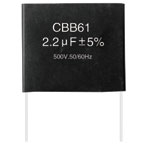-
Location:
- Home
- > news center > cooperative R & D

In a DC circuit, a capacitor is equivalent to an open circuit.
This has to start from the structure of the capacitor. A simple capacitor is composed of plates at both ends and an insulating dielectric in the middle [2]. After energization, the plates are charged to form a voltage (potential difference), but because the middle is an insulating material, it is not conductive. However, such a situation is under the premise that the critical voltage (breakdown voltage) of the capacitor is not exceeded. We know that any substance is relatively insulating. When the voltage across the substance increases to a certain level, the substance can conduct electricity. We call this voltage breakdown voltage. The capacitor is no exception. After the capacitor is broken down, it is not an insulator. However, in the middle school stage, such a voltage is not visible in the circuit, so it works below the breakdown voltage and can be seen as an insulator.
However, in AC circuits, because the direction of current changes with time as a certain function. The process of charging and discharging the capacitor takes time. At this time, a changing electric field is formed between the plates, and this electric field is also a function of time. In fact, the current passes between the capacitors in the form of a field.